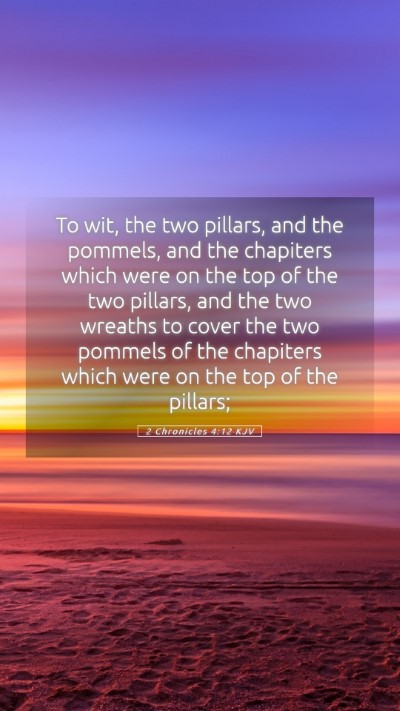Understanding 2 Chronicles 4:12
This verse, 2 Chronicles 4:12, reads: "To wit, the two pillars, and the pommels, and the chapiters which were on the top of the two pillars, and the two networks, to cover the two pommels of the chapiters which were upon the top of the pillars." This verse forms an important part of the construction of the Temple as described in 2 Chronicles, shedding light on various elements of its architecture and their significances.
Bible Verse Interpretations
From the insights of public domain commentaries, we can derive a deeper understanding of this verse:
-
Matthew Henry: He emphasizes the magnificence and intricacy of the temple's construction. The pillars were not merely structural; they symbolized strength and stability. Henry also notes that they were adorned elaborately, signifying the glory of God dwelling among His people.
-
Albert Barnes: Barnes expounds on the components of the pillars, suggesting that each part had purpose and meaning, serving as a representation of the covenant between God and Israel. Their detailed craftsmanship reflected on the devotion and seriousness with which the Temple was built, representing the holiness associated with worship.
-
Adam Clarke: Clarke provides insight into the artistic imagery depicted in this verse. He highlights the networks and pommels as indicative of divine favor and the aesthetic beauty that should accompany worship. Clarke expounds that the design itself directs attention to God, establishing a visual sermon about His majesty.
Bible Verse Commentary
This verse not only discusses physical attributes but extends into theological implications:
-
Symbolism of Pillars: The pillars can be seen as a representation of the people of God who uphold His teachings and their faith in the world.
-
Artistry in Worship: The intricate details provided by God regarding the Temple's construction encourage the belief that worship should engage both the heart and the senses, reflecting the glory of God through beauty.
Biblical Exegesis and Analysis
Examining 2 Chronicles 4:12 reveals essential truths about the worship culture of ancient Israel:
-
Historical Context: This verse reflects the historical significance of the temple in Israel’s national identity and spirituality. The construction was a communal effort aimed at creating a dwelling place for God amongst His people.
-
Relational Aspect: The building of the temple and its furnishings, including the pillars, symbolized the relationship God sought to maintain with His people through worship and sacrifice.
Application of Bible Verse
2 Chronicles 4:12 invites reflection on how we approach worship today:
- Incorporating creativity and beauty in our worship practices can enhance our connection with the divine.
- Understanding the symbolic significance of our actions in worship helps to deepen our faith and awareness of God's presence.
- Recognizing the importance of a communal approach to worship can foster unity and strength among believers.
Cross References
This verse is related to several other scriptures that provide additional insight:
- 1 Kings 7:15-22 - Description of the pillars in Solomon's temple.
- Exodus 25:10-22 - God's instructions for building the Ark of the Covenant, reflecting a theme of divine specification.
- Psalms 84:1-4 - The beauty and importance of God's dwelling place.
Conclusion
In summary, understanding 2 Chronicles 4:12 involves recognizing its architectural specificity, its symbolic depth, and its reflection of a loving relationship between God and humanity. Through these insights, we uncover broader principles of worship that remain relevant today.
For Further Study
Engaging in Bible study groups or utilizing online Bible study tools can deepen the understanding of scripture passages like this one. It is essential to explore various Bible study resources and Bible study guides to enrich interpretation and application of biblical texts.
Keywords Summary
This analysis aligns with important keywords for deeper exploration:
- Bible verse meanings
- Bible verse interpretations
- Bible verse understanding
- Using Bible study materials
- How to interpret Bible verses


